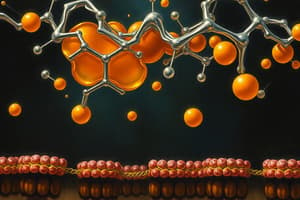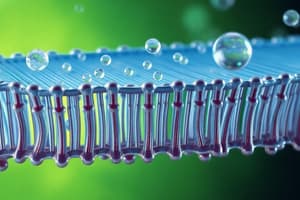Podcast
Questions and Answers
What lifestyle modification has the greatest impact on reducing the risk of high cholesterol?
What lifestyle modification has the greatest impact on reducing the risk of high cholesterol?
- Engaging in regular exercise
- Drinking alcohol in moderation
- Losing extra pounds and maintaining a healthy weight (correct)
- Increasing intake of processed foods
Which of the following factors correlates positively with the risk of developing heart disease?
Which of the following factors correlates positively with the risk of developing heart disease?
- High physical activity levels
- High HDL cholesterol levels
- Young age
- Male gender (correct)
How does type 2 diabetes influence cholesterol metabolism?
How does type 2 diabetes influence cholesterol metabolism?
- It enhances the absorption of dietary fats.
- It promotes higher triglyceride levels. (correct)
- It decreases HDL cholesterol production.
- It directly lowers LDL cholesterol levels.
Which lipid disorder is characterized by the accumulation of cerebrosides in the tissues?
Which lipid disorder is characterized by the accumulation of cerebrosides in the tissues?
Which dietary approach is most effective in managing blood cholesterol levels?
Which dietary approach is most effective in managing blood cholesterol levels?
Which of the following lipoprotein classes is primarily responsible for transporting cholesterol away from the arteries to the liver?
Which of the following lipoprotein classes is primarily responsible for transporting cholesterol away from the arteries to the liver?
What is a common skin manifestation of lipid storage disorders?
What is a common skin manifestation of lipid storage disorders?
Which marker indicates inflammation and is associated with increased risk for heart disease?
Which marker indicates inflammation and is associated with increased risk for heart disease?
What percent of the body's cholesterol is produced endogenously?
What percent of the body's cholesterol is produced endogenously?
Which of the following lipoproteins is known as 'bad' cholesterol due to its association with atherosclerosis?
Which of the following lipoproteins is known as 'bad' cholesterol due to its association with atherosclerosis?
From which sources does the body obtain exogenous cholesterol?
From which sources does the body obtain exogenous cholesterol?
What is the advisable HDL cholesterol level for adults to reduce heart disease risk?
What is the advisable HDL cholesterol level for adults to reduce heart disease risk?
Which of the following conditions is characterized by elevated cholesterol levels in the blood?
Which of the following conditions is characterized by elevated cholesterol levels in the blood?
What is the optimal total cholesterol level recommended for adults?
What is the optimal total cholesterol level recommended for adults?
Which lipid disorder is directly linked to elevated triglyceride levels?
Which lipid disorder is directly linked to elevated triglyceride levels?
What is the primary function of HDL in cholesterol metabolism?
What is the primary function of HDL in cholesterol metabolism?
What percentage of the body's cholesterol needs are met by endogenous synthesis?
What percentage of the body's cholesterol needs are met by endogenous synthesis?
Which lipoprotein class is responsible for transporting dietary lipids from the intestines to the liver?
Which lipoprotein class is responsible for transporting dietary lipids from the intestines to the liver?
What components are primarily found in a lipoprotein's core?
What components are primarily found in a lipoprotein's core?
Which of the following is NOT part of a heart-healthy diet?
Which of the following is NOT part of a heart-healthy diet?
What role does HDL cholesterol play in cardiovascular health?
What role does HDL cholesterol play in cardiovascular health?
Which health condition can be caused by high levels of LDL cholesterol in the blood?
Which health condition can be caused by high levels of LDL cholesterol in the blood?
What is one of the functions of lipids in the body?
What is one of the functions of lipids in the body?
What lifestyle change can help manage high blood cholesterol?
What lifestyle change can help manage high blood cholesterol?
Flashcards
Fatty Liver
Fatty Liver
Accumulation of fat in the liver.
Obesity
Obesity
Having excess body fat.
High Cholesterol Prevention
High Cholesterol Prevention
Ways to lower the risk of high cholesterol: healthy diet, exercise, managing weight etc.
High Cholesterol Risk Factors
High Cholesterol Risk Factors
Signup and view all the flashcards
Lipid Metabolism Disorders
Lipid Metabolism Disorders
Signup and view all the flashcards
Essential Fatty Acid Deficiency
Essential Fatty Acid Deficiency
Signup and view all the flashcards
Heart Disease Risk Factors
Heart Disease Risk Factors
Signup and view all the flashcards
High LDL Cholesterol
High LDL Cholesterol
Signup and view all the flashcards
Endogenous Cholesterol
Endogenous Cholesterol
Signup and view all the flashcards
Exogenous Cholesterol
Exogenous Cholesterol
Signup and view all the flashcards
LDL Cholesterol
LDL Cholesterol
Signup and view all the flashcards
HDL Cholesterol
HDL Cholesterol
Signup and view all the flashcards
Desirable Total Cholesterol
Desirable Total Cholesterol
Signup and view all the flashcards
Hypercholesterolemia
Hypercholesterolemia
Signup and view all the flashcards
Blood Lipid Disorders
Blood Lipid Disorders
Signup and view all the flashcards
Optimal LDL Cholesterol
Optimal LDL Cholesterol
Signup and view all the flashcards
What is the link between high cholesterol and heart disease?
What is the link between high cholesterol and heart disease?
Signup and view all the flashcards
What are lipoproteins?
What are lipoproteins?
Signup and view all the flashcards
What are the functions of lipids?
What are the functions of lipids?
Signup and view all the flashcards
Cholesterol synthesis
Cholesterol synthesis
Signup and view all the flashcards
Chylomicrons
Chylomicrons
Signup and view all the flashcards
What are the two main ways to manage high cholesterol?
What are the two main ways to manage high cholesterol?
Signup and view all the flashcards
Study Notes
Cholesterol Structure and Biomedical Importance
- Cholesterol is a steroid and sterol.
- It's a crucial component of cell membranes, acting as a bidirectional regulator of membrane fluidity.
- At high temperatures, it stabilizes the membrane and increases its melting point.
- At low temperatures, it intercalates between phospholipids, preventing clustering and stiffening.
- Higher cholesterol concentrations increase membrane thickness and reduce permeability to small molecules.
- Cholesterol's hydroxyl group is oriented towards the aqueous phase, making this end hydrophilic.
- Cholesterol's structure comprises a cyclopentanoperhydrophenanthrene ring system.
- It has a hydroxyl group at carbon 3, a double bond between carbons 5 and 6, an eight-carbon side chain at carbon 17, and methyl groups at carbons 10 and 13.
- Total carbon atoms are 27.
Cholesterol and Diseases
- High cholesterol is a risk factor for conditions like atherosclerosis, heart disease, and myocardial infarction.
- High LDL cholesterol is considered “bad” cholesterol because it can deposit in artery walls, contributing to plaque buildup, narrowing, and potentially blood clots.
- Low HDL cholesterol is considered “good” cholesterol, involved in transporting cholesterol from organs/blood to the liver to remove it, thus preventing accumulation (cleaning blood).
- Hypercholesterolemia is a condition characterized by very high cholesterol levels in the blood.
- Diseases like atherosclerosis, diabetes mellitus, hyperlipoproteinemia, fatty liver, and lipid storage diseases are associated with abnormal lipid metabolism.
- Emerging risk factors include CRP, homocysteine, and Lp(a) protein.
Sources of Cholesterol
- Endogenous cholesterol is produced in the body (liver, 75%).
- Exogenous cholesterol comes from food (animal products, 25%).
- Cholesterol in animal products (egg yolks, meat, poultry, shellfish, milk) is absorbed, and increased intake lowers absorption, excreting about 1g daily.
Cholesterol's Functions
- Cholesterol is essential for normal cell growth and repair.
- It's a precursor for steroid hormones (estrogen, progesterone, testosterone, corticosteroids, aldosterone).
- Essential for the synthesis of vitamin D.
- Needed for absorption of fat-soluble vitamins.
- Crucial for the production of bile acids, aiding fat digestion.
- Cholesterol is needed to maintain neurotransmitter and brain function, and build brain and nerve tissue. It is needed for good sleep, learning, memory formation, and nerve cell function (Myelin).
Cholesterol-Related Compounds
- Bile acids are synthesized from cholesterol in the liver and contain 24 carbon atoms (e.g., cholic acid, chenodeoxycholic acid).
- Cholesterol is a crucial component of cell membranes, giving them structural integrity and influencing their permeability and fluidity.
Cholesterol in the Body
- Free cholesterol (about 30%) and ester form (about 70%) are present in the body.
- Blood cholesterol levels depend on both genetics and the environment.
- Cholesterol's role in membrane fluidity is important in maintaining physiological function.
- It regulates membrane fluidity by preventing the tails from crystallizing at low temperatures, and stabilizes at high temperatures, thus maintaining fluidity. Cholesterol regulates membrane fluidity by preventing crystallization .
Lipoproteins
- Lipoproteins are essential for transporting lipids in the blood.
- Types of lipoproteins include chylomicrons, VLDL, LDL, and HDL.
Today's case and Gall stones
A 45-year-old obese lady experiencing vomiting and abdominal pain, radiating to her right shoulder, worsening after dinner, with a history of hypertension and hypercholesterolemia, had multiple gallstones revealed by ultrasound.
Treatment for Atherosclerosis
- A heart-healthy diet (fruits, vegetables, whole grains, fish, lean meats, poultry, low-fat dairy, nuts, seeds, legumes)
- Brisk walking (30 minutes)
- Quit smoking
- Control weight, blood sugar, hypertension
Studying That Suits You
Use AI to generate personalized quizzes and flashcards to suit your learning preferences.




